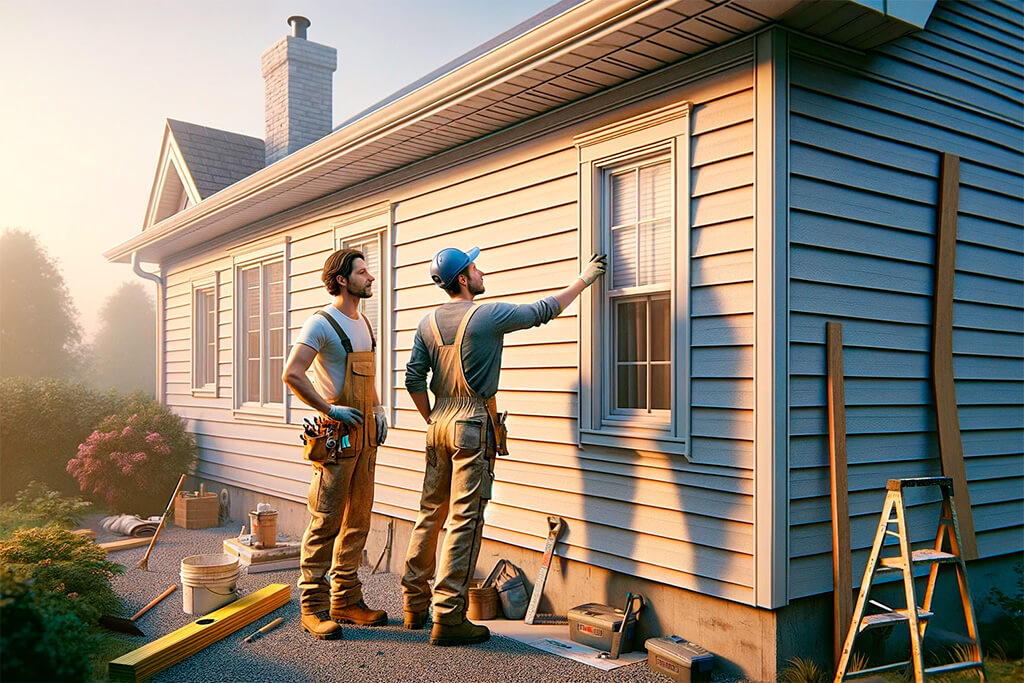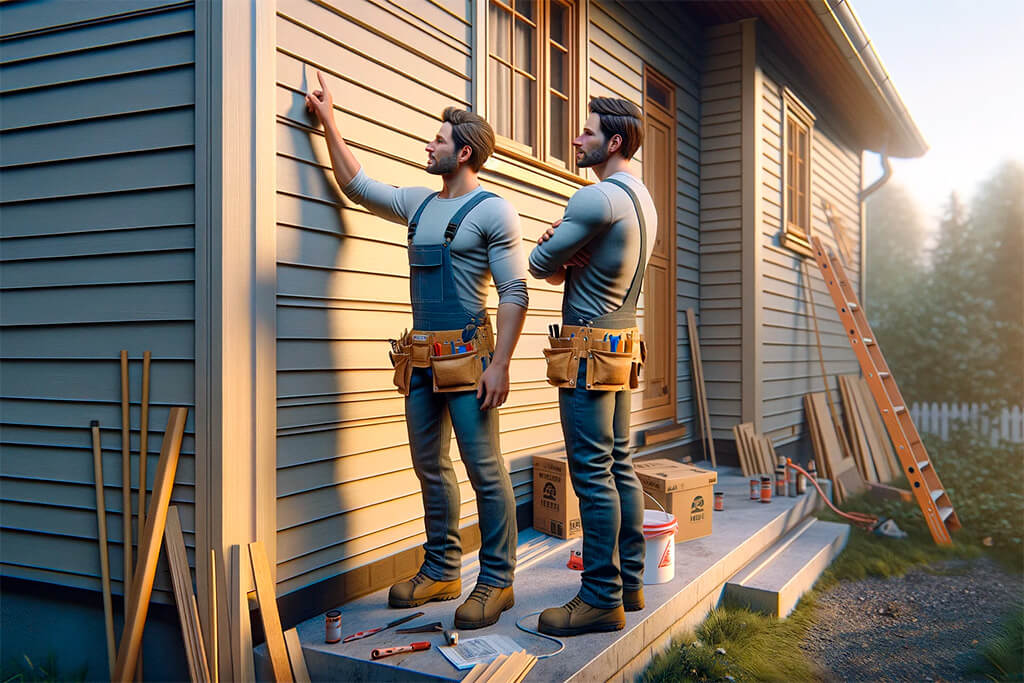In the world of home construction, siding isn’t just another component, it’s the backbone of your home’s exterior. It’s the protective shell that keeps the elements at bay while defining your home’s character and curb appeal. Over my years in renovation, I’ve seen how the right siding choice not only protects a home but also transforms it, elevating its aesthetic and market value.
Choosing siding goes beyond color or style. It’s about picking the right shield to protect against varying weather conditions and enhancing your home’s appearance. This choice can make a significant difference in maintenance needs and energy efficiency, not to mention its impact on resale value.

Understanding Siding: An Overview
Siding Defined
Siding serves as the outer covering or cladding of a house, offering protection and insulation while contributing to its overall look. It’s the first barrier against the elements – rain, snow, sun, and wind.
A Brief History in the U.S.
Siding has evolved over the years, mirroring changes in technology and style preferences. From traditional wood clapboards to modern, high-tech options, siding in America tells a story of innovation and adaptation.
Types of Siding Materials
Vinyl Siding: The Practical Choice
- Pros:
– Low maintenance and easy to clean.
– Affordable, a good option for budget-conscious homeowners.
– Wide range of colors and styles. - Cons:
– Vulnerable to extreme weather conditions.
– Can be perceived as less upscale than other materials. - Ideal Usage: Great for those looking to update their home’s exterior without breaking the bank.
Wood Siding: Time-Honored and Versatile
- Characteristics:
– Offers a natural, timeless look.
– Highly customizable with paint or stain. - Maintenance:
– Regular maintenance, including painting and sealing, is necessary to prevent rot and deterioration. - Aesthetic Appeal: Provides a classic, warm appearance that’s hard to replicate with other materials.
Fiber Cement Siding: Durable and Stylish
- Durability: Resistant to fire, rot, and termites.
- Cost: More expensive initially but cost-effective in the long term.
- Design Options: Available in a variety of textures and styles, mimicking wood, stucco, or masonry.
Metal Siding: Contemporary and Resilient
- Benefits:
– Excellent resistance to weather and fire.
– Gives buildings a modern, industrial look.
Brick and Stone Veneer: Elegance and Longevity
- Timeless Elegance: Offers a classic and sophisticated appearance.
- Longevity: Extremely durable with minimal maintenance required.
Stucco Siding: Customizable and Charming
- Mediterranean Charm: Offers a unique, textured look.
- Customization: Can be tinted in various colors and textured for a distinctive appearance.
Composite Siding: The Innovative Alternative
- Innovative Solutions: Combines various materials for enhanced durability and performance.
- Eco-friendly: Often made from recycled materials, offering a sustainable option.

Factors to Consider When Choosing Siding
Climate and Weather Resistance: Matching Materials to Your Region
- Weather Considerations: It’s crucial to select siding that can withstand your local weather. For instance, in hurricane-prone areas, sturdier options like fiber cement may be ideal. In contrast, if your region experiences intense heat, certain types of vinyl siding are designed to resist warping and fading.
- Insulation Needs: In colder regions, choosing siding with good insulative properties, such as insulated vinyl or wood, can provide additional warmth and reduce heating costs.
Maintenance Requirements: Long-term Care for Different Siding Types
- Ease of Maintenance: Some siding materials, like vinyl, offer ease of maintenance, requiring only occasional cleaning with mild soap and water.
- Regular Upkeep: On the other hand, wood siding, while aesthetically appealing, demands more maintenance such as periodic painting or staining to prevent decay and maintain its appearance.
Aesthetic Appeal: Complementing Your Home’s Architectural Style
- Harmony with Home Design: The siding should complement your home’s architectural style. Modern homes may benefit from the sleek lines of metal siding, while traditional homes may look best with classic wood or brick veneer.
- Color Considerations: The color of your siding should harmonize with the overall color scheme of your home, including the roof, trim, and surrounding landscape.
Budget Considerations: Cost-Effectiveness and Long-Term Value
- Initial Cost vs. Lifespan: While some materials like vinyl are more cost-effective upfront, others like fiber cement offer greater longevity and may be more cost-effective over time.
- Boosting Resale Value: High-quality siding can enhance your home’s curb appeal and potentially increase its resale value.
Environmental Impact: Eco-Friendly and Sustainable Choices
- Sustainable Options: Consider environmentally friendly materials, such as composite siding made from recycled materials, to reduce your ecological footprint.
- Energy Efficiency: Some siding options offer better insulation, helping to reduce energy consumption and potentially lower utility bills.
Installation and Professional Advice
DIY vs Professional Installation: What to Know Before You Start
- Assessing Your Skills: Installing siding requires a certain level of skill and experience. While DIY installation can be cost-effective, it may not be suitable for those without prior experience in home renovation.
- Required Tools and Time Commitment: Ensure you have the necessary tools and time. Siding installation can be a time-consuming process, requiring a variety of tools and equipment.
Tips for Hiring a Skilled Contractor
- Research and Vetting: Conduct thorough research when selecting a contractor. Look for experience, licensure, and positive reviews from previous clients.
- Clear Agreements: Ensure all aspects of the project, including costs, materials, and timelines, are clearly outlined in a written contract.
Common Installation Mistakes to Avoid
- Accurate Measurements: Accurate measurements are critical to avoid wastage of material and additional costs.
- Adhering to Manufacturer Instructions: Each type of siding comes with specific installation instructions from the manufacturer. Following these guidelines is crucial for the longevity and performance of the siding.
- Surface Preparation: Proper preparation of the surface where the siding will be installed is vital. This includes ensuring the surface is clean, dry, and smooth.

Maintenance and Upkeep
Routine Maintenance Tips for Different Siding Types
- Vinyl Siding: This one’s a breeze to maintain. A regular wash with a garden hose, some gentle soap, and a soft brush is usually all you need. Also, make a habit of inspecting for loose or damaged panels, especially after severe weather.
- Wood Siding: Requires more attention but rewards you with timeless beauty. Regular inspections for moisture or insect damage are key. Repainting or staining every few years will keep it in top condition.
- Fiber Cement Siding: Quite resilient, it needs less frequent maintenance. A good cleaning and repainting every decade or so will suffice.
- Metal Siding: Generally low maintenance. A simple rinse occasionally and checking for any scratches or dents that might need attention will do.
Addressing Common Issues: Warping, Cracking, and Fading
- Warping: Often a result of heat exposure or improper installation, replacing affected panels is the best course of action.
- Cracking: Common in colder climates. Replacing cracked panels promptly will prevent further damage.
- Fading: Sun exposure can dull colors over time. Refreshing the paint or a thorough cleaning can restore its original vibrancy.
Long-term Care for Sustained Durability and Appearance
- Regular Inspections: Routine checks can prevent minor issues from becoming major problems.
- Sealing and Caulking: Essential for keeping moisture out. Make sure these are in good shape to prevent water infiltration.
- Consistent Cleaning: A clean siding not only looks good but also prevents build-up that can lead to damage.
Trends and Innovations in Siding
Emerging Trends in Siding Materials and Designs
- Sustainable Materials: There’s a growing trend towards using eco-friendly materials like recycled metal or composite siding.
- Experimenting with Colors and Textures: Homeowners are increasingly opting for bold colors and unique textures, making personal statements with their home exteriors.
Technological Advancements: Smart Siding Solutions
- Insulated Siding: This innovation greatly enhances energy efficiency, providing better temperature control inside the home.
- Self-Cleaning Siding: Some of the latest materials are designed to repel dirt and water, significantly reducing maintenance needs.
FAQ Section
Vinyl usually offers the best cost-effectiveness initially. However, materials like fiber cement, although more expensive upfront, might offer better value in the long run due to their durability and low maintenance needs.
The lifespan of siding varies with the material. Vinyl and metal can last 20-40 years, while well-maintained wood siding can endure even longer. Key indicators for replacement include warping, cracking, or extensive rot.
DIY installation is feasible for some siding types, like vinyl, which are more user-friendly. However, for more complex materials like fiber cement, or if you lack the skills and tools, professional installation is recommended for optimal results.
It’s important to consider the architectural style of your home and its natural surroundings. Choose a color and style that complements these elements. Keep in mind that some colors may require more maintenance due to faster fading.
Yes, there are several environmentally friendly options available. Materials like recycled composite or metal siding are sustainable choices. Also, siding that offers better insulation can be considered eco-friendly due to its energy-saving properties.
